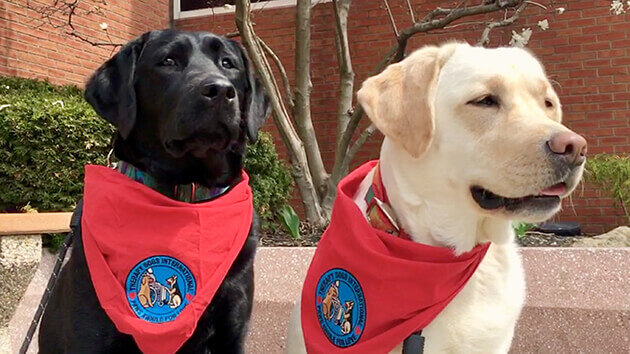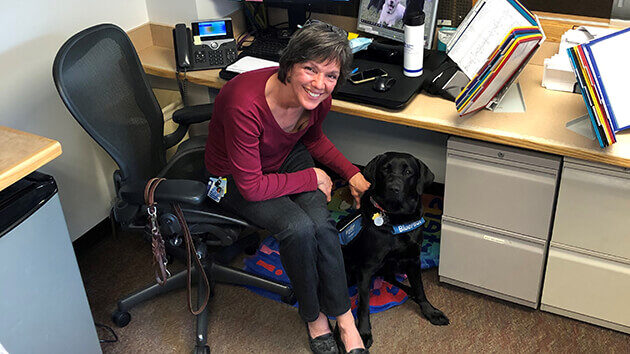The Mary Poppins of the Puppy World

There are certain things you would expect an Albany Med employee might bring to work. An ID badge? Most definitely. Scrubs? A stethoscope? Sure.
But a dog?
For much of the past eight years, Senior Access Coordinator Aimee Muller, BSN, has brought a revolving cast of Labrador retrievers—and one German shepherd—into work with her in the morning.
“I keep a foldable puppy crate under my desk,” she said. “On breaks and lunch hours they go everywhere with me. They love the grassy field behind the College. The waterfall wall in the waiting room of the pediatric Emergency Department is another favorite. They’re mesmerized by it.”
As a volunteer “puppy raiser” for organizations like Guiding Eyes for the Blind and Blue Path Autism, Muller fosters young pups destined for lives as service dogs. If they master the education they receive following the 12-16 months they live with Muller, they might serve as a guide dog for someone who is visually impaired or a service dog for a child with autism.
Muller’s furry protégés have been notably successful: five of the six she has fostered have gone on to careers as guide or service dogs, and the sixth “may still have an alternate career as an explosives detection dog who sniffs out bombs and other hazards,” she said.
Born on a farm in Keeseville, Essex County, Muller has always loved animals. “Anything that looked sick I took care of it,” she said. “If a baby bird fell out of a nest I was there. Mice. Squirrels. You name it.” She went on to a career in nursing and spent 25 years in the Emergency Department. Today, she works in the Patient Access Center, coordinating the safe entry of patients who arrive from other hospitals and clinics in need of the advanced care that Albany Med provides. “We’re like the air traffic control of the Medical Center,” she said.
To be granted permission to bring the pups into work, Muller received departmental and supervisor approval, and, despite their cuteness, the dogs have to follow the rules just like everyone else (“on their first day their photos get put on an ID badge that they’re required to wear,” Muller said). They are considered junior therapy dogs by Volunteer Services, which runs a robust pet therapy program.
“Because they’re still in training, they’re not allowed in patient rooms like the full-fledged therapy dogs at Albany Med,” Muller explained, “but they can do meet-and-greets in the hallways.”
She remembers a day when she passed a very young girl who was standing next to her mother at an elevator bank, crying inconsolably and refusing to go to the clinic upstairs. Attuned to the situation, Muller stopped and let the child pet her then-foster dog, Wrigley. “Just like that, she calmed down,” she said. “I said to the mother, ‘If you’d like I can get in the elevator and ride with you?’” The foursome made the trip to the clinic together, the girl staying close to Wrigley’s side.
Muller’s colleagues, too, have found themselves gravitating to the dogs. “We love having them here,” said Patient Triage Manager Bob Palumbo, RN. “Aimee brings them in to expose them to new sights and sounds, but, for us, they’re pure therapy. We spoil them sometimes when she’s not looking. She’s just terrific with them.”
Muller’s time with her trainees is finite. After her work is done, the dogs return to their home organizations for continued education and a hoped-for match with a person in need. “It’s hard to let them go,” she said, “but I walk around the Medical Center and I’m constantly struck by how much this work matters. I see patients accompanied by their service dogs. And I don’t lose touch with them completely. I stay in touch with the people they are matched with. I go to their graduation ceremonies. They’ll come bounding up to me, full of excitement. We have a saying in this line of work: ‘They’re in your life for a year, but they’re in your heart forever.’
She credits Albany Med for their impressive credentials. “Service dogs need to be calm, cool and collected, no matter what is happening around them,” she said. “They need to be able to tune out distractions, and Albany Med offers plenty of those, so it’s a wonderful training setting. There are wheelchairs and carts and lots of foot traffic, people pushing IV poles down the hallway, people coming out of the cafeteria with trays of food. Ambulances. Sirens. Stairs. I could go on….”
